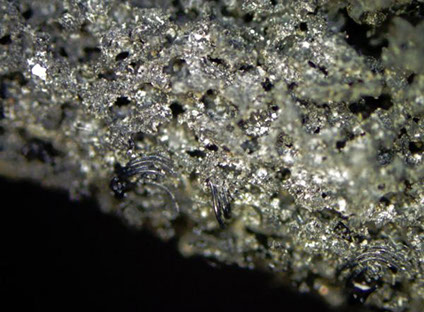
COPYRIGHTS AND RESTRICTIONS AND CONDITIONS OF THIS WEBSITE
BATMAN: A PRESERVATION SPECIALIST WORKS TO SAVE HOLLYWOOD'S BATSUITS
The props and costumes of Hollywood have become big business at the auction block and, right or wrong, are taking on the aura of true cultural artifacts in our celebrity-obsessed era. But like many relics, they face the danger of time and mistreatment. To shed some light on it, preservation specialist Ron Barbagallo has written a guest essay on the fragile treasures of Gotham City (one of which returns to the screen this weekend in Los Angeles with the American Cinematheque screening of Tim Burton’s Batman)
The insidious danger comes from below. Liquids oozes up to wreak havoc on a foundation that seemed solid, but now suddenly cracks with fissures that spiral out of control. Malicious gases rise and permeate, damaging everything in their path. No, this is not part of some super-villain’s diabolical plot to destroy Gotham or Metropolis, but there are heroes in danger in this scenario. I’m talking about the impending peril that I thwart daily while preserving Disney animation cels and other art made with painted plastic materials. I am the art conservator and director of Animation Art Conservation, and for nearly 25 years (along with my partner in all things chemical, conservation scientist Michele Derrick) I’ve worked to protect Walt Disney animation cels, as well as other motion-picture artifacts such as Tim Burton’s painted plastic puppets or the on-screen Batman suits, from further degradation.
The costume of Batman has lived in the public imagination since the Franklin Roosevelt administration, has stayed close enough to that original color scheme and overall profile that fans of any age know the hero when they see him on the page, on the screen or ringing the doorbell on Halloween. What has changed, here in Hollywood, is the cloth and thread which the hero wears on the screen. In the movie-serial years, filmmakers translated comic book drawings with stitched fabric but in recent decades there has been a new array of materials specialized plastics poured into molds, for instance, have given Gotham’s caped crusader a pliable body armor. It’s an understanding of those plastics where a new conservation expertise comes into play.
Christian Bale in The Dark Knight (Warner Bros)
Similar to canvas and paper, Disney animation cel sheets are made of cellulose nitrate and cellulose acetates, starting out as cotton and/or wood, which are chemically altered until they become clear and pliable. More modern plastics, like polyester, are made of entirely synthetic materials. All of them have their Achilles’ heel. Light, temperature, humidity, mishandling and age come into play separately, and at times contribute collectively to the degradation of a plastic object.
As my colleague, Derrick, puts it: Natural rubbers, as well as many types of synthetic rubbers, are very susceptible to deterioration from light, heat, and oxygen. Under normal room conditions, these materials slowly lose their elasticity and structural integrity. Research has shown that preventive measures, such as cool temperatures or low-oxygen environments, can minimize degradation reactions.
With all art, wear and tear is a concern too. But unlike paintings or drawings, plastic superhero suits get a workout on a movie set, where the temperament of the actors and stunt-people wearing them comes into play. For instance, credit goes to Bale, whose Batman Begins suit far outshines the other Batman costumes I’ve examined when it comes to post-production condition. Keaton’s Bat-suit from the first Burton film, released in 1989, suffered far more from wear and tear, but perhaps that can be attributed to the era and the pioneer role it served in the overall business of Gotham moviemaking.
As with degraded or worn woven fabric flags or cloth costumes, careful handling can prevent damage to areas that will be more noticeable down the road and specialized linings can be useful to hold elements of a superhero suit together. One of the biggest things to remember with all art is whatever you do with it, you are creating a relationship between the object and the place you put it. In other words, if you want to put your money into Batman’s possessions, make you sure find the right cave to store it in.
© Ron Barbagallo and Geoff Boucher.
ALL RIGHTS RESERVED. You may not quote or copy from this article without written permission.
YOUR USE OF THIS WEBSITE IMPLIES YOU HAVE READ AND AGREE TO THE "COPYRIGHT AND RESTRICTIONS/TERMS AND CONDITIONS" OF THIS WEBSITE DETAILED IN THE LINK BELOW:
LEGAL COPYRIGHTS AND RESTRICTIONS / TERMS AND CONDITIONS OF USE
INSTRUCTIONS ON HOW TO QUOTE FROM THE WRITING ON THIS WEBSITE CAN BE FOUND AT THIS LINK.
PLEASE DO NOT COPY THE JPEGS IN ANY FORM OR COPY ANY LINKS TO MY HOST PROVIDER. ANY THEFTS OF ART DETECTED VIA MY HOST PROVIDER WILL BE REPORTED TO THE WALT DISNEY COMPANY, WARNER BROS. OR OTHER LICENSING DEPARTMENTS.
ARTICLES ON AESTHETICS IN ANIMATION
BY RON BARBAGALLO:
The Art of Making Pixar's Ratatouille is revealed by way of an introductory article followed by interviews with production designer Harley Jessup, director of photography/lighting Sharon Calahan and the film's writer/director Brad Bird.
Design with a Purpose, an interview with Ralph Eggleston uses production art from Wall-E to illustrate the production design of Pixar's cautionary tale of a robot on a futuristic Earth.
Shedding Light on the Little Matchgirl traces the path director Roger Allers and the Disney Studio took in adapting the Hans Christian Andersen story to animation.
The Destiny of Dalí's Destino, in 1946, Walt Disney invited Salvador Dalí to create an animated short based upon his surrealist art. This writing illustrates how this short got started and tells the story of the film's aesthetic.
A Blade Of Grass is a tour through the aesthetics of 2D background painting at the Disney Studio from 1928 through 1942.
Lorenzo, director / production designer Mike Gabriel created a visual tour de force in this Academy Award® nominated Disney short. This article chronicles how the short was made and includes an interview with Mike Gabriel.
Tim Burton's Corpse Bride, an interview with Graham G. Maiden's narrates the process involved with taking Tim Burton's concept art and translating Tim's sketches and paintings into fully articulated stop motion puppets.
Wallace & Gromit: The Curse Of The Were-Rabbit, in an interview exclusive to this web site, Nick Park speaks about his influences, on how he uses drawing to tell a story and tells us what it was like to bring Wallace and Gromit to the big screen.
For a complete list of PUBLISHED WORK AND WRITINGS by Ron Barbagallo,
click on the link above and scroll down.
This article is a recreation of the one that was posted by Geoff Boucher to his Hero Complex column in The Los Angeles Times. It originally ran in May 14, 2011.
INDEX OF SERVICES
The Ethical Method of Repair
The Attention is in the Details
the Lost and FOUND series
RON BARBAGALLO:
BATMAN:
A PRESERVATION SPECIALIST WORKS TO SAVE HOLLYWOOD'S BATSUITS
2011 © Ron Barbagallo and Michele Derrick from Geoff Boucher's Hero Complex column at the LA Times

A cut edge of black foamed fabric and threading used in the Batman Begins Batsuit.
Reflected light micrograph at 50x magnification
Microscopy and Image © Michele Derrick

As cool as plastic superhero suits look on the screen, storing them after a wrapped production is left to Hollywood archives and private collectors lucky enough to get one. And, hopefully, caring for their chemistry becomes the task of art conservation professionals. I came to work on the Michael Keaton Batsuit from the Burton era, and the Christian Bale Batsuit from the more recent films by Christopher Nolan, and found interesting commonalities with the Walt Disney animation production art. The funny thing about painted plastics such as animation cels is the perception that they are Space Age products and immune to deterioration over time. Most people know that fabric or paper will wither in their own ways, but presume that plastics are like Dorian Gray, impervious to degrading. It turns out they have more in common with that hidden portrait in Oscar Wilde’s tale.

Batman from 1989 (Warner Bros)